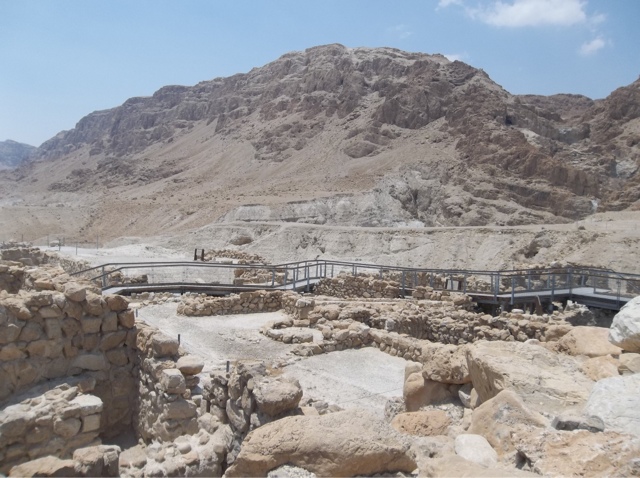First, we wandered the gladiator theater. The various entrances were different sizes, we can only assume because of the various entrants: the smaller shorter ones appeared to be for wild animals while the tall and skinny ones were for their human opponents.
A short drive away, we wandered the other excavated part of the city. There, the various layers of city built atop city were revealed. The majority of the revealed architecture was Roman: the grand colonnade, the dry and steam saunas, the theaters, and various other buildings. The grand columns reached skyward, though a few were left toppled to show the way that they were found.
Roman columns may be strong, but they were no match for the earthquakes that routinely shake this region. At one place, the three layers of mosaic floors were revealed: Roman, Byzantine, and Muslim art tiered by century. For an aerial view, Josh and I also hiked to the top of the hill, surveying the city layout. Atop the hill were also a recreated Egyptian structure and others - further evidence of the recycling of cities and locations.
Next we stopped at Qumran, the site where the original Dead Sea Scrolls were found. They were discovered in 1947 by members of a Bedouin tribe who threw a rock down into a cave while herding goats and heard the smash of pottery breaking. They climbed down inside and found carefully wound leather scrolls with ancient Hebrew writing, stored in clay pots. It wasn't until the scrolls had changed hands several times that their true value was realized: they were decoded and revealed as ancient Hebrew texts outlining the lives and rules of the Essenes. This peaceful sect spent their days waiting for the End of Days and shared everything communally. Every routine act had an associated ritual. And all of this was written down on the Dead Sea Scrolls that have been found in the last half century.
Nearby where these scrolls were found (they have since been moved to the Israel Museum in Jerusalem), an excavation uncovered a building complex with rooms for the scribes, for communal eating, and for the other daily activities.
Many artifacts were found here, from communal bowls to inkwells. We wandered the site, appreciating the harsh beauty of the desert and the courage of populations that make their home here. It was here that we also got our first glimpse of the Dead Sea, the water a gorgeous green-blue. The sea was edged in white where salt crystals had grown along the shore. I couldn't wait to swim in it.
We finished the afternoon with a hike at Ein Gedi, a park with several pools and waterfalls where locals go for a dip to cool off in the hot summer heat.
Due to falling rocks, swimming is not prohibited in certain areas. Danny told us that the ibex have learned to kick rocks at people, too.
Driving certain places is also off-limits, due to sinkholes that form. But we made it safely to Ein Bokek on the Dead Sea, in time to watch the sun set over the chalky yellow mountains and the aquamarine waters.
Spotted: Hitchhikers. Hitchhiking used to be popular among members of the Israeli army, young students trying to travel or get home. Since several soldiers were kidnapped by terrorists this way, the army has forbidden hitchhiking by its members and the practice has generally declined. But the other interesting tweak? Hitchhikers don't ask for a ride by sticking out a thumb. Instead they stick out a pointer finger, horizontally, as if pointing at the car they're hoping will give them a ride.






No comments:
Post a Comment